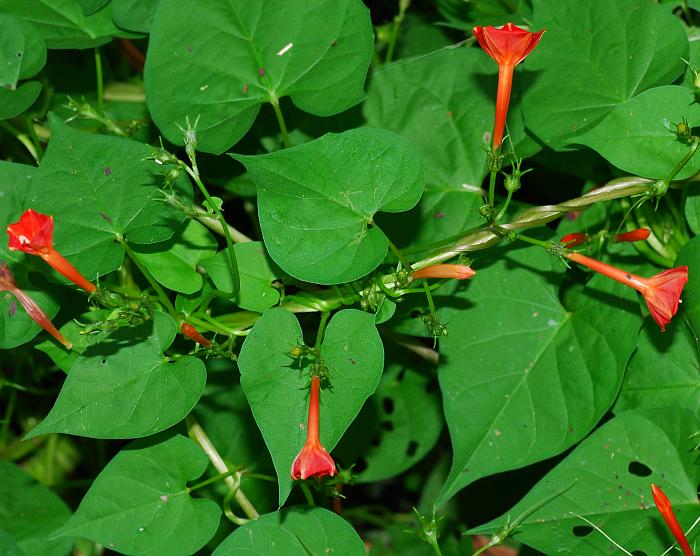Ipomoea coccinea L.
Red Morning Glory

Introduced
CC = *
CW = 3
MOC = 33
© SRTurner
Ipomoea coccinea L.Red Morning Glory | |
 |
Introduced CC = * CW = 3 MOC = 33 |
© SRTurner |
|
Family - Convolvulaceae Habit - Annual forb. Stems - Twining, twisting, scrambling on other vegetation, to 3 m, glabrous to sparsely pubescent at the nodes, angled. Leaves - Alternate, simple, petiolate. Petioles to 6 cm, glabrous to sparsely pubescent, with an adaxial groove. Blades 2-12 cm long, usually with a pair of short, downward-pointing or somewhat spreading basal lobes, broadly ovate to somewhat sagittate in outline, tapered to a sharply pointed tip, glabrous or inconspicuously short-hairy toward the base, the lobes triangular to narrowly triangular, cordate at the base, sharply pointed at the tip, the margins sometimes also with a few short teeth toward the base.
Inflorescence - Axillary, loose clusters of 2-8 flowers on long peduncles. Peduncles to 9 cm, glabrous, angled, twisted. Pedicels to 1.5 cm, glabrous. Inflorescence divisions subtended by a pair of bracts, these 3 mm long, 1 mm broad, acuminate, glabrous.
Flowers - Sepals similar in size and shape or the outer 2 slightly shorter and narrower, the main body 3-7 mm long, broadly oblong-elliptic, rounded or truncate at the tip but with a slender, tapered awn 2-6 mm long from just below the tip, glabrous. Corollas 2.0-3.5 cm long, to 2 cm broad, trumpet-shaped, the tube slender, widened abruptly at the tip, orangish red to red, with the tube and throat often yellow to yellowish orange, glabrous. Stamens 5, exserted, adnate about 6mm above the base of the corolla tube. Ovary 4-locular, the stigma 2-lobed. Filaments whitish-orange, glabrous but with retrorse papillose glands near the base. Anthers yellow, 1.2 mm long. Style 1, exserted beyond stamens, white, glabrous. Ovary superior, yellowish, glabrous, 4-locular, 4-seeded, 1.3 mm long, 1 mm in diameter. Placentation axile. Ovary subtended by whitish nectary.
Fruits - Globose capsules 5-7 mm long, the persistent style 3-4 mm long, glabrous. Seeds 3.2-3.6 mm long, the surface densely pubescent with minute, curly hairs.
Flowering - June - October. Habitat - Streambanks, gravel bars, pastures, fencerows, ditches, fields, railroads, roadsides, moist open disturbed areas. Also cultivated. Origin - See below. Lookalikes - None. Very similar to the introduced species I. hederifolia, which has not been found in Missouri. Flowers are similar to those of I. quamoclit, but that species has completely different leaves. Other info. - This attractive vine is found in scattered locations in Missouri, most commonly in the southern third of the state, and is also scattered throughout the eastern U.S. It is recognized by its firecracker-red trumpet-shaped flowers and heart-shaped leaves. The striking flowers are a beacon to butterflies and hummingbirds. The plant can be aggressive if given the right conditions. It is not all that common, but can be prolific where it is found. A particularly favored habitat seems to be gravel bars and banks of medium-sized rivers. Photographs taken in Brown Summit, NC., 9-8-02 (DETenaglia); also along the Katy Trail near Augusta, St. Charles County, MO, 9-21-2011, 9-20-2017, and 8-29-2021(SRTurner). |